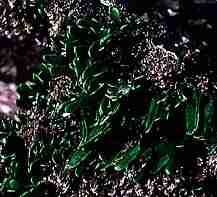|
|

Caulerpa Caulerpa filiformis
Form:
 Caulerpa
is a seaweed with a dense mass of bright green, small, strap-like leaves
called ramuli. Each ramuli measures
100-200 mm long and 5 mm wide.
Caulerpa
is a seaweed with a dense mass of bright green, small, strap-like leaves
called ramuli. Each ramuli measures
100-200 mm long and 5 mm wide.
The cartilage-like stem of the plant, called a stolon, grows flat along the rock attached by fine outgrowths. Growing out from the stolon are five rows of photosynthetic ramuli, each of which tapers to a short, blunt, spinous tip.
Colour:
Caulerpa is really bright green in colour. It is a very noticeable algae.
Phylum: |
Chlorophyta |
Author: |
(Suringar) Hering |
Family: |
Caulerpaceae |
Size: |
Thallus to 180 mm |
Distribution:
 In
Australia, this species of Caulerpa, occurs only in New South Wales.
In
Australia, this species of Caulerpa, occurs only in New South Wales.
Recent research reveals that it also occurs in South Africa. It is uncertain whether it is a recent immigrant from Africa, but many researchers state that it wasn't as abundant only as recent as 20 years ago. It was first recorded near Sydney in 1923. It appears to be taking over large areas and is crowding out other algae forms.
Habitat:
Caulerpa is found at low-tide levels along the edges of rock platforms and in gutters, on medium- to high-energy shores, down to 40 metres. It can be found near Cunjevoi at low-tide level.
Biology:
There is evidence that this algae is a recent immigrant from South Africa. It appears to be taking over many habitats along the New South Wales rocky shores, so that it is now the most abundant algae to be found. It is so common that it may be reaching pest, or even plague proportions, and excluding other local species.
Another explanation for
this rapid take-over may be due to human pollution altering the habitat
so much that only this species can take advantage of the new conditions.
Question:
How can we test these hypotheses out ?
References:
Bennett, I. (1987) W.J. Dakin's classic study: Australian Seashores. Angus & Robertson, Sydney.
Davey, K. (1998) A Photographic Guide to Seashore Life of Australia. p.22, New Holland, Sydney.
Edgar, G. J. (1997) Australian Marine Life: the plants and animals of temperate waters. p.37, Reed Books, Kew.
Sea
Lettuce
Green Sea Velvet
Caulerpa
Home
Page
Taxonomy
Biogeography
Rocky Shores
Tidal Levels
Intertidal Zonation
Environmental Factors
Biological
Factors
Feeding Relationships
Activities
Glossary
References
 Life
on Australian Seashores
Life
on Australian Seashores
by Keith Davey (C) 2000
Learning Consultant
- Media
The University of Newcastle
email at australian_seashores@hotmail.com
Scientific Consultant: Phil
Colman
site created 01.01.98 : updated 01.04.2000